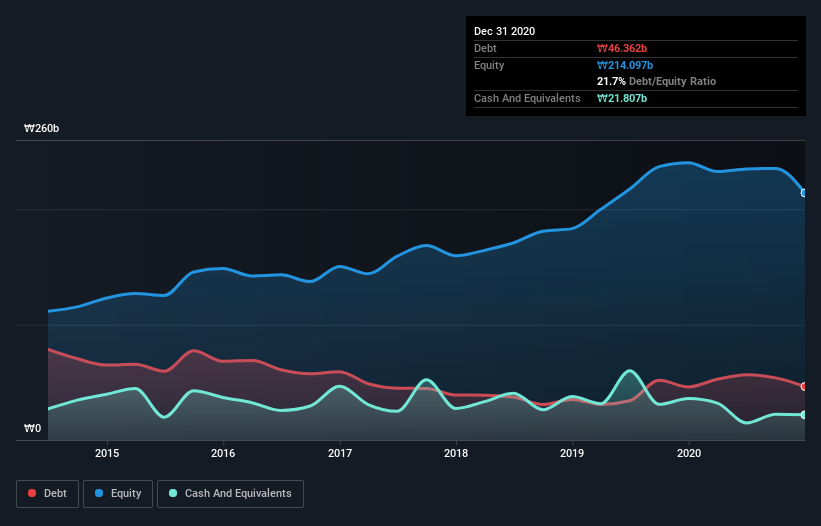- South Korea
- /
- Semiconductors
- /
- KOSDAQ:A047310
We Think Powerlogics (KOSDAQ:047310) Has A Fair Chunk Of Debt
Legendary fund manager Li Lu (who Charlie Munger backed) once said, 'The biggest investment risk is not the volatility of prices, but whether you will suffer a permanent loss of capital.' So it seems the smart money knows that debt - which is usually involved in bankruptcies - is a very important factor, when you assess how risky a company is. As with many other companies Powerlogics Co., Ltd. (KOSDAQ:047310) makes use of debt. But the more important question is: how much risk is that debt creating?
When Is Debt A Problem?
Debt and other liabilities become risky for a business when it cannot easily fulfill those obligations, either with free cash flow or by raising capital at an attractive price. If things get really bad, the lenders can take control of the business. However, a more usual (but still expensive) situation is where a company must dilute shareholders at a cheap share price simply to get debt under control. Of course, the upside of debt is that it often represents cheap capital, especially when it replaces dilution in a company with the ability to reinvest at high rates of return. The first thing to do when considering how much debt a business uses is to look at its cash and debt together.
Check out our latest analysis for Powerlogics
What Is Powerlogics's Net Debt?
As you can see below, Powerlogics had ₩46.4b of debt, at December 2020, which is about the same as the year before. You can click the chart for greater detail. On the flip side, it has ₩21.8b in cash leading to net debt of about ₩24.6b.

A Look At Powerlogics' Liabilities
Zooming in on the latest balance sheet data, we can see that Powerlogics had liabilities of ₩151.5b due within 12 months and liabilities of ₩5.90b due beyond that. Offsetting these obligations, it had cash of ₩21.8b as well as receivables valued at ₩73.5b due within 12 months. So it has liabilities totalling ₩62.1b more than its cash and near-term receivables, combined.
While this might seem like a lot, it is not so bad since Powerlogics has a market capitalization of ₩282.3b, and so it could probably strengthen its balance sheet by raising capital if it needed to. However, it is still worthwhile taking a close look at its ability to pay off debt. There's no doubt that we learn most about debt from the balance sheet. But it is Powerlogics's earnings that will influence how the balance sheet holds up in the future. So if you're keen to discover more about its earnings, it might be worth checking out this graph of its long term earnings trend.
Over 12 months, Powerlogics made a loss at the EBIT level, and saw its revenue drop to ₩927b, which is a fall of 16%. We would much prefer see growth.
Caveat Emptor
While Powerlogics's falling revenue is about as heartwarming as a wet blanket, arguably its earnings before interest and tax (EBIT) loss is even less appealing. To be specific the EBIT loss came in at ₩26b. When we look at that and recall the liabilities on its balance sheet, relative to cash, it seems unwise to us for the company to have any debt. So we think its balance sheet is a little strained, though not beyond repair. However, it doesn't help that it burned through ₩12b of cash over the last year. So suffice it to say we do consider the stock to be risky. When analysing debt levels, the balance sheet is the obvious place to start. However, not all investment risk resides within the balance sheet - far from it. We've identified 1 warning sign with Powerlogics , and understanding them should be part of your investment process.
If, after all that, you're more interested in a fast growing company with a rock-solid balance sheet, then check out our list of net cash growth stocks without delay.
When trading stocks or any other investment, use the platform considered by many to be the Professional's Gateway to the Worlds Market, Interactive Brokers. You get the lowest-cost* trading on stocks, options, futures, forex, bonds and funds worldwide from a single integrated account. Promoted
New: Manage All Your Stock Portfolios in One Place
We've created the ultimate portfolio companion for stock investors, and it's free.
• Connect an unlimited number of Portfolios and see your total in one currency
• Be alerted to new Warning Signs or Risks via email or mobile
• Track the Fair Value of your stocks
This article by Simply Wall St is general in nature. It does not constitute a recommendation to buy or sell any stock, and does not take account of your objectives, or your financial situation. We aim to bring you long-term focused analysis driven by fundamental data. Note that our analysis may not factor in the latest price-sensitive company announcements or qualitative material. Simply Wall St has no position in any stocks mentioned.
*Interactive Brokers Rated Lowest Cost Broker by StockBrokers.com Annual Online Review 2020
Have feedback on this article? Concerned about the content? Get in touch with us directly. Alternatively, email editorial-team (at) simplywallst.com.
About KOSDAQ:A047310
Powerlogics
Manufactures and sells electric circuits, protection devices, and camera modules in South Korea and internationally.
Good value with adequate balance sheet.
Market Insights
Community Narratives



